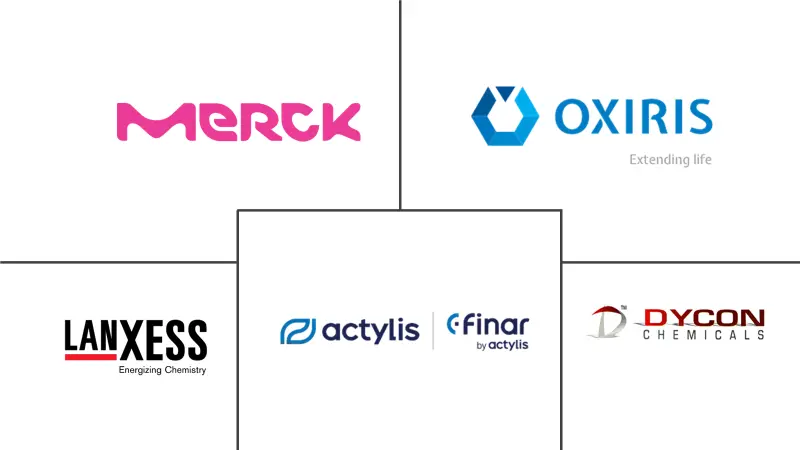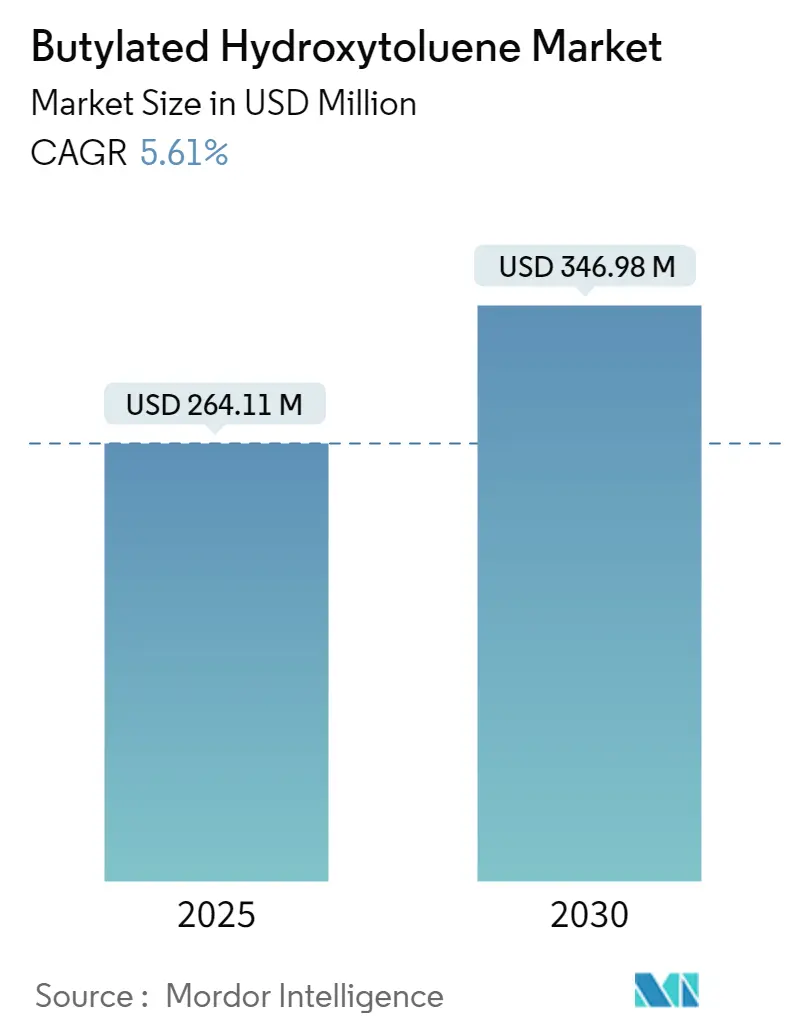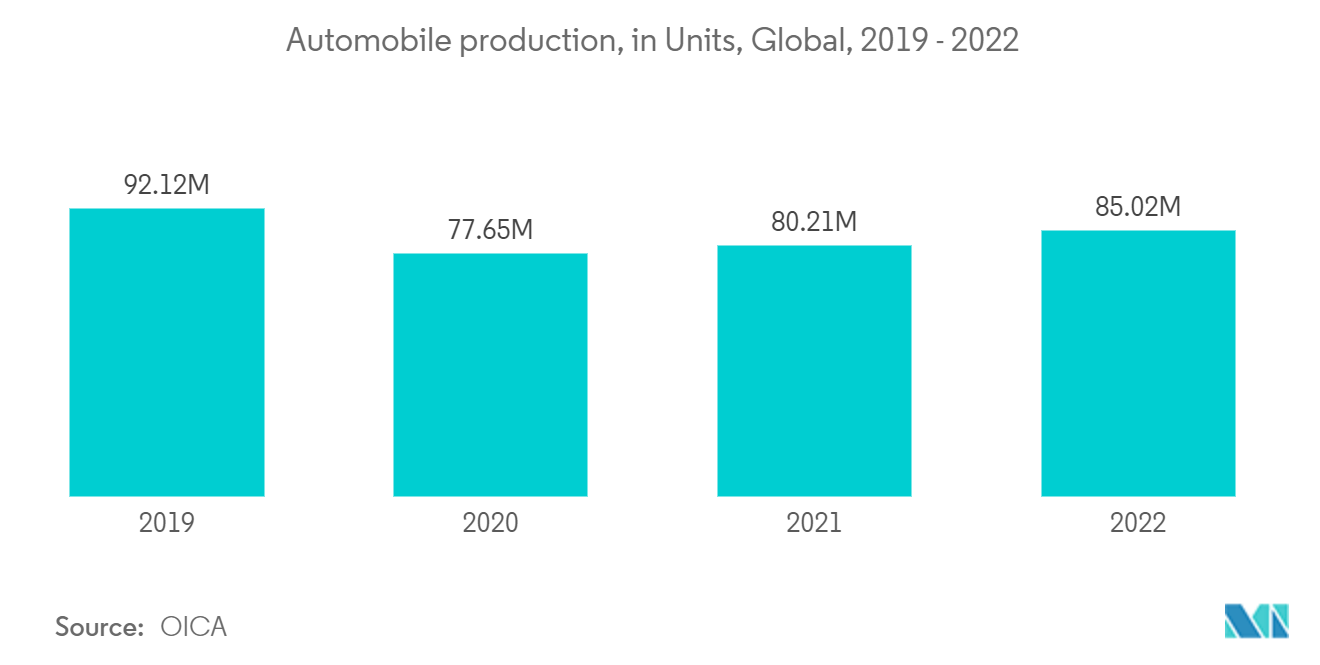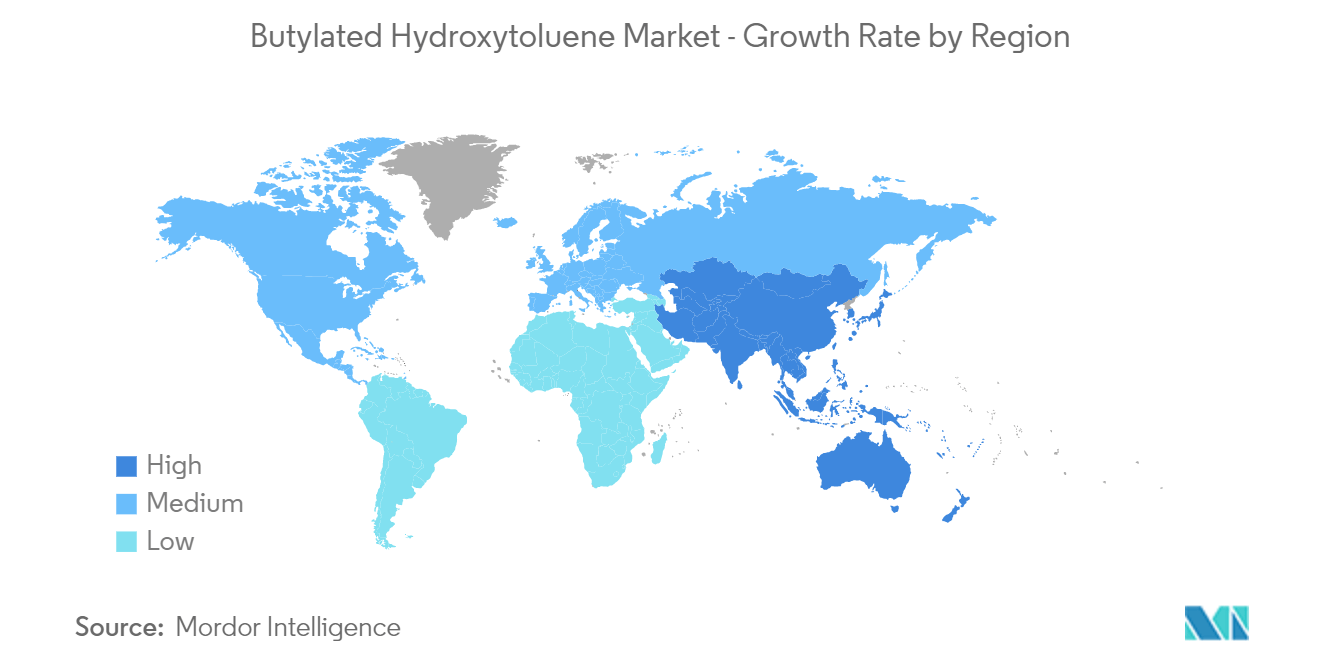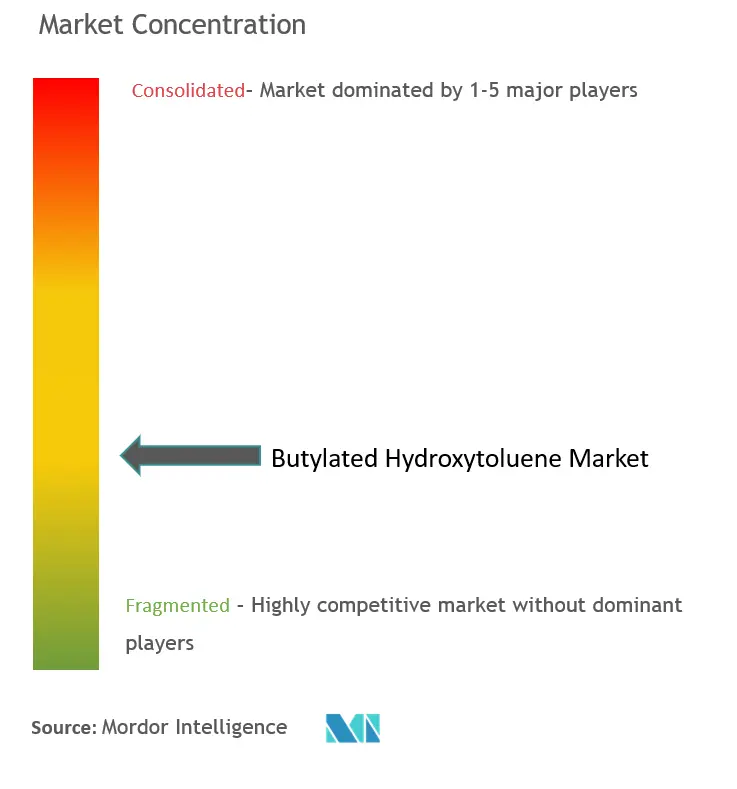Butylated Hydroxytoluene Market Analysis
The Butylated Hydroxytoluene Market size is estimated at USD 264.11 million in 2025, and is expected to reach USD 346.98 million by 2030, at a CAGR of 5.61% during the forecast period (2025-2030).
The outbreak of coronavirus disease (COVID-19) has acted as a massive restraint on the plastics and rubber products manufacturing market in 2020. The supply chains were disrupted due to trade restrictions, and consumption declined due to lockdowns imposed by governments globally, which eventually led to the closure of various manufacturing units pertaining to rubber, personal care, and food and beverage processing industries. This has led to a decrease in the demand in the butylated hydroxytoluene market globally. However, on the flip side, due to rising health concerns, the sudden increase in demand for PPE kits and personal care and hygiene products such as sanitizers, detergents, etc., in the pandemic scenario has provided opportunities for the growth of the butylated hydroxytoluene market.
- Over the medium term, the major factor driving the butylated hydroxytoluene market is the increasing demand for antioxidants from the polymer industry. Plastic antioxidants are additives that are added during plastic production to eliminate thermal and oxidation degradation, and they help in increasing the shelf-life of products. The usage of plastic antioxidants in polypropylene polymer resin is projected to be the highest during the forecast period as polypropylene usage has increased in packaging applications, which is likely to drive the plastic antioxidant market, stimulating the demand for the market studied.
- On the flip side, stringent regulations due to increasing health concerns are expected to hinder the growth of the market.
- By end-user industry, the plastics and rubber industry is expected to dominate the market studied over the forecast period.
- The Asia-Pacific region represents the largest market and is also expected to be the fastest-growing market over the forecast period, owing to the increasing consumption from countries such as China, India, and Japan, among others.
Butylated Hydroxytoluene Market Trends
Increasing Demand from the Plastics and Rubber Industry
- Butylated hydroxytoluene is widely used in the plastics and rubber industry owing to its antioxidant characteristics, and its usage is expected to grow rapidly during the forecast period.
- Earlier, rubber was coated with antioxidants to protect it from oxidation, and once the outer coating wears off, the unprotected rubber will instantly undergo oxidation. Chemicals are incorporated into the rubber during mixing instead of coating the rubber surface to prevent this.
- Antioxidants react with oxygen trapped in the rubber compound during mechanical mixing and later bleed to the surface, thereby providing complete protection for rubber from oxidation.
- Similarly, in plastics, oxidation leads to discoloration and general disorientation. It can either be caused by oxidation or free radical generation. Free radicals are generated due to heat, mechanical stress, and radiation. Antioxidants react with free radicals and prevent the degradation of plastics.
- Moreover, according to the World Economic Forum, by the year 2050, global plastic production is expected to reach three times. Therefore, the growing demand for plastics is expected to drive the market demand for butylated hydroxytoluene.
- The demand for rubber is increasing in recent years. For instance, on October 2022, Bridgestone Corporation announced that it approved plans to invest USD 26.7 million to strengthen its investments in its rubber plantations in South East Asia. The investments aim to ensure a sustainable natural rubber supply for producing tires.
- Furthermore, the growing demand for plastics and rubber from various industries, such as automotive and packaging, is expected to drive the butylated hydroxytoluene market. For instance, according to OICA, in 2022, almost 85 million motor vehicles were produced worldwide, which shows an increase of 6% compared with 2021. As a result, an increase in automobile production is expected to increase demand for rubber tires, creating an upside for the butylated hydroxytoluene market.
- Moreover, in October 2022, RMKH Glove launched the first glove manufacturing facility in the Kingdom of Cambodia at the Manhatten Special Economic Zone in Bavet. The manufacturing facility contains an annual capacity of over 600 million pieces and helps the local farmers to market their natural rubber and increases the rubber market in the region.
- All the factors above will likely be the driving forces behind the butylated hydroxytoluene market during the forecast period.
Asia-Pacific to Dominate the Market
- The Asia-Pacific region is expected to dominate the market for butylated hydroxytoluene during the forecast period, owing to the increase in consumption from countries like India and China.
- Some of the largest butylated hydroxytoluene producers are in the Asia-Pacific region. Some of them include Honshu Chemical Industry Co. Ltd, Milestone Preservatives Pvt. Ltd, Ratnagiri Chemicals Pvt. Ltd, Dycon Chemicals, VDH Chem Tech Pvt. Ltd, and FINAR, among others.
- Butylated hydroxytoluene is an antioxidant food additive that protects unsaturated organic compounds in foods and oils from atmospheric oxidation.
- Association of Natural Rubber Producing Countries (ANRPC), Malaysia's rubber exports dropped to RM 35.99 billion ( USD 8.169 billion) in 2022 compared with RM 71.01 billion ( USD 16.11 billion) in 2021. Therefore, a decrease in rubber exports is expected to affect the studied market's growth.
- Moreover, the growth in automobile production in China will likely promote the demand for rubber tires, creating an upside demand for the butylated hydroxytoluene market. For instance, in 2022, around 2,70,20,615 units of automobiles were produced in the country, which shows an increase of 3% compared with 2021.
- According to the National Bureau of Statistics of China, in January 2022, the retail trade revenue of cosmetics in China amounted to about USD 9.18 billion. It reached about USD 9.76 billion in January 2023. As the demand for cosmetic products expands further in second-and third-tier cities of China, the butylated hydroxytoluene market is expected to maintain its growth momentum shortly. In addition, the changing attitude among men toward skin care fosters the booming men's cosmetics market in China.
- Most of the rubber products, such as tires, are a blend of natural and synthetic rubber. India is the sixth-largest producer of natural rubber globally, with a production capacity of approximately 775,000 metric tons in 2022. Furthermore, India was the second largest consumer of natural rubber worldwide in 2021, behind China. India's natural rubber consumption decreased by almost 10% in 2020 but rebounded by 21% in 2021 to 1.3 million metric tons.
- Moreover, according to India Brand Equity Foundation (IBEF), the Indian e-commerce industry is on an upward growth trajectory, and it is expected to surpass the United States to become the second-largest e-commerce market in the world by 2034. Therefore, the growth of the e-commerce industry is expected to create an upside demand for the butylated hydroxytoluene market in the country.
- Furthermore, over the next five years, the Indian e-retail industry is projected to exceed ~300-350 million shoppers, propelling the online Gross Merchandise Value (GMV) to USD 100-120 billion by 2025. The increase in internet penetration and the change in government policies allowing 100% foreign direct investments in the e-commerce sector are expected to boost the consumption of plastics.
- Therefore, the factors above, coupled with government support, are expected to contribute to the increasing demand for the butylated hydroxytoluene market in the Asia-Pacific region during the forecast period.
Butylated Hydroxytoluene Industry Overview
The Butylated Hydroxytoluene Market is partially fragmented in nature. The major players in this market (not in a particular order) include LANXESS, Merck KGaA, OXIRIS CHEMICALS, FINAR, and Dycon Chemicals.Hydroxytoluene
Butylated Hydroxytoluene Market Leaders
-
Merck KGaA
-
Dycon Chemicals
-
LANXESS
-
OXIRIS CHEMICALS
-
FINAR
- *Disclaimer: Major Players sorted in no particular order
Butylated Hydroxytoluene Market News
July 2022: ChemPoint, a subsidiary of Univar Solutions, was chosen by shelf-life extension solutions provider CFS North America, under Camlin Fine Sciences, for the sales and distribution of its Xtendra BHT (butylated hydroxytoluene) product throughout the US and Canada.
Butylated Hydroxytoluene Industry Segmentation
The addition reaction of p-cresol and either 2-methylpropene or isobutylene produces butylated hydroxytoluene (BHT). It is widely used as an antioxidant and a stabilizing agent in cosmetics and personal care products. It helps preserve the properties and functionality of materials exposed to air and vulnerable to oxidation, such as odor, color, and texture. The market is segmented based on type, end-user industry, and geography. By type, the market is segmented into food grade and technical grade. By end-user industry, the market is segmented into plastics and rubber, food and beverage, personal care and cosmetics, animal feed, and other end-user industries. The report offers market size and forecasts for 15 countries across major regions. For each segment, market sizing and forecasts are based on revenue (USD) for all the above segments.
| Type | Food Grade | ||
| Technical Grade | |||
| End-user Industry | Plastics and Rubber | ||
| Food and Beverage | |||
| Personal Care and Cosmetics | |||
| Animal Feed | |||
| Other End-user Industries | |||
| Geography | Asia-Pacific | China | |
| India | |||
| Japan | |||
| South Korea | |||
| Rest of Asia-Pacific | |||
| North America | United States | ||
| Canada | |||
| Mexico | |||
| Europe | Germany | ||
| United Kingdom | |||
| Italy | |||
| France | |||
| Rest of Europe | |||
| South America | Brazil | ||
| Argentina | |||
| Rest of South America | |||
| Middle-East and Africa | Saudi Arabia | ||
| South Africa | |||
| Rest of Middle-East and Africa | |||
Butylated Hydroxytoluene Market Research FAQs
How big is the Butylated Hydroxytoluene Market?
The Butylated Hydroxytoluene Market size is expected to reach USD 264.11 million in 2025 and grow at a CAGR of 5.61% to reach USD 346.98 million by 2030.
What is the current Butylated Hydroxytoluene Market size?
In 2025, the Butylated Hydroxytoluene Market size is expected to reach USD 264.11 million.
Who are the key players in Butylated Hydroxytoluene Market?
Merck KGaA, Dycon Chemicals, LANXESS, OXIRIS CHEMICALS and FINAR are the major companies operating in the Butylated Hydroxytoluene Market.
Which is the fastest growing region in Butylated Hydroxytoluene Market?
Asia Pacific is estimated to grow at the highest CAGR over the forecast period (2025-2030).
Which region has the biggest share in Butylated Hydroxytoluene Market?
In 2025, the Asia Pacific accounts for the largest market share in Butylated Hydroxytoluene Market.
What years does this Butylated Hydroxytoluene Market cover, and what was the market size in 2024?
In 2024, the Butylated Hydroxytoluene Market size was estimated at USD 249.29 million. The report covers the Butylated Hydroxytoluene Market historical market size for years: 2019, 2020, 2021, 2022, 2023 and 2024. The report also forecasts the Butylated Hydroxytoluene Market size for years: 2025, 2026, 2027, 2028, 2029 and 2030.
Our Best Selling Reports
Butylated Hydroxytoluene Industry Report
Statistics for the 2025 Butylated Hydroxytoluene market share, size and revenue growth rate, created by Mordor Intelligence™ Industry Reports. Butylated Hydroxytoluene analysis includes a market forecast outlook for 2025 to 2030 and historical overview. Get a sample of this industry analysis as a free report PDF download.

